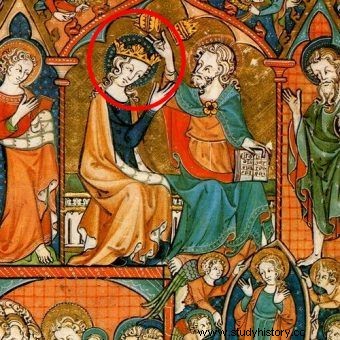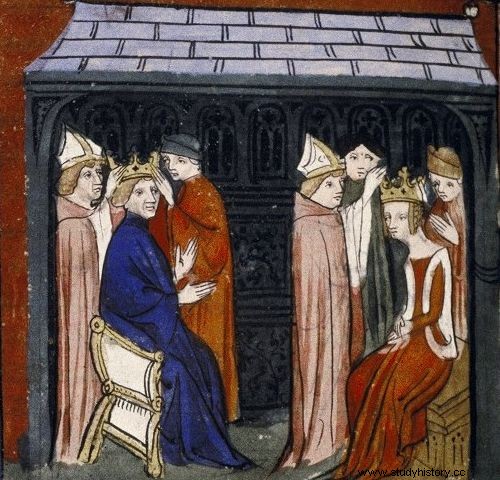In 1025, after a quarter of a century of efforts, wars and stalking, Poland finally became a kingdom. Archbishop Hipolit put the crown on the heads of Bolesław the Brave and his son Mieszko. But they were not the only heroes of the events at all.
The first Polish coronation has already been discussed in countless books and articles. You can read from them that at Easter, i.e. on the most important holiday in the church calendar, a common, double ceremony took place. A solution well known from Germany. Otto II became king and even emperor while his father was still alive. It was similar in the next generation. Konrad II will soon return to the old tradition, putting his eleven-year-old heir to the throne.

Coronation of the Virgin Mary presented in the so-called Oswald Psalter (10th century).
There is no doubt that the principle remained in force and that it could be easily transplanted into Polish soil. It should be emphasized, however, that in 1025 there was no double coronation after all. The Piasts became kings only because at the same time a third person was wearing the crown. The wife of Mieszko II, Riches:niece of the German emperor, who was their living link with the Carolingian tradition.
Pious ceremony
It was a purely religious ritual. Although no chronicler has described what happened on that extraordinary day, fortunately, numerous examples of other women's coronations are known. Above all:the early medieval Ordines. have been preserved to our times

Coronation of the king and queen on a French miniature from the 14th century.
Books containing detailed rules for elevating female rulers to the rank of queens. They are collections of prayers, uttered lines, and at the same time peculiar programs of the ceremony. They come from the time of the first successors of Charlemagne. You can guess that it was the tradition stored in them that Rycheza was based on when she prepared her own coronation together with the new archbishop of Gniezno.
New Sarah and Rachel
In detail Ordines differ, but common points are easy to find. This solemn ceremony made the princess a kind of viceroy of the Mother of God on earth. Just as anointed kings represented Christ in the mortal world, their wives were to follow the example of the Queen of Heaven. As royal brides, they took on the responsibility of defending the oppressed. They were expected to uphold the justice of their husbands and to intercede for their subjects. They were also supposed to follow the best biblical models.
Archbishop Hippolytus must have likened his lady to the great women of the Old Testament. This was done according to each Ordo . From then on, Richeza was to follow in the footsteps of Sarah, Rachel and Leah. It was supposed to be a model of spiritual and physical purity, but also ... a model of beauty.
Presence above all
The most influential collection of coronation rules - prepared by Archbishop Reims Hincmar at the end of the 9th century - placed particular emphasis on the importance of female beauty. Monarchini had to be able to present herself. Rycheza did not have any problems with this. Examples of slightly later Slavic coronation ceremonies suggest that she put on the most beautiful of her dresses. The challenge was elsewhere.
In the Ottonian pontificals from the mid-10th century you can find The Queen's Blessing. A special prayer delivered during the coronation. It begins with an open criticism of female weakness. However, this is only a rhetorical ploy. The writer of the complaining text quickly moves on to praise the other sex. And it hangs the bar very high. He commands the queens to be like Judith and Esther. Women who, alone, at the time of the greatest trial, saved God's people ...

Queen of Rycheza in the illustration by Jan Matejko.
Of course, their struggle was meant to be just a symbol. Nobody expected freshly baked monarchs to begin their day with beheading the closest Assyrian military general (like Judith) or with plots to stop the extermination of the chosen people (like Esther). But when the heavy, gilded crown rested on the temples of Riches, and Archbishop Hippolytus made the sign of the cross on her forehead, the Queen did not feel that she was facing a purely spiritual struggle.
She saw Bolesław the Brave in front of her. Pale, feverish and supported by servants, he looked as if one foot had already been in the grave ... His death was a matter of weeks, if not days. And it was hard to predict what would happen when he was gone. Maybe nothing in the Bible:just a flood.
Selected bibliography:
The article was based on materials collected by the author during the work on the book "Damy z skazą. The women who crowned Poland " . Some of these items are shown below. Full bibliography in the book.
- M.V. Fox, Character and Ideology in the Book of Esther , Grand Rapids 2001.
- Z. Dalewski, The coronation of Mieszko II [in:] Historia narrat. Medieval studies offered to Professor Jacek Banaszkiewicz , ed. A. Pleszczyński, J. Sobiesiak, M. Tomaszek, P. Tyszka, Lublin 2012.
- Kosmas, Chronicle of the Czechs , Fr. II, ch. 38.
- G. Labuda, Mieszko II, King of Poland (1025–1034). Times of breakthrough in the history of the Polish state , Poznań 2008.
- W. Mischke, Polish crown of Czech kings , "Studia Źródłoznawcze", vol. 44 (2006).
- G. Pac, Biblical Judith in the ideology of queenship of the Early Middle Ages [in:] Et credidit populus. The role and function of beliefs in early societies , eds. J. Szacillo, J. Eaton, S. McDaid , "Quest", vol. 8 (2009).
- G. Pac, The coronations of female rulers in the early Middle Ages - an outline of the problem [in:] Gniezno royal coronations and their Central European contexts , eds. J. Dobosz, M. Matla, L. Wetesko, Gniezno 2011.
- A. Pleszczyński, Germany towards the first Piast monarchy (963-1034). The birth of the stereotype , Lublin 2008.
- P. Schreiner, Queen of Rycheza, Poland and Rhineland. Relations between Poles and Germans in the 11th century , Poznań – Cologne 1996.
- H. Wolfram, Conrad II, 990–1039. Emperor of Three Kingdoms , University Park 2006.
